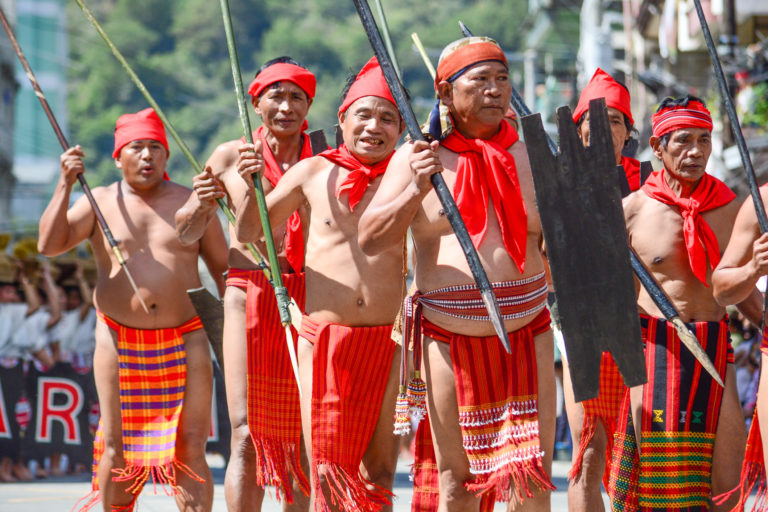- Indigenous groups in the Cordillera region of the northern Philippines have invoked indigenous rituals to lock down their communities against the threat of the COVID-19 pandemic.
- The region is inhabited predominantly by indigenous peoples, with more than 15 distinct ethnolinguistic groups.
- Because of this, tribal leaders are often elected in seats of local governance, which, in turn, helps in the preservation of indigenous practices, culture and governance.
- The provinces in the region implemented strict “indigenous lockdowns” immediately after the pandemic hit the country, and have since recorded minimal cases of infections.
BONTOC, Philippines — Each weekend since March, no one has crossed the boundary into the town of Bauko, in the northern Philippine region of Cordillera. The prohibition, a municipal advisory, was prompted by the invocation of a tengao by community elders, many of whom are also local officials.
A tengao is the indigenous variation of a lockdown; once invoked, it means no one can enter or leave the community for a day or more, depending on the consensus of the council of elders.
Different towns across Mountain Province, one of six that make up the Cordillera region, have invoked this practice, which is also called te-er, to-or, sedey, far-e, ubaya, or tungro by varying ethnolinguistic groups. The Cordillera region is inhabited predominantly by indigenous peoples, with more than 15 distinct ethnolinguistic groups, according to the National Commission on Indigenous Peoples (NCIP). As such, tribal leaders and councils of elders play influential roles in governance.
Municipal councils across Cordillera have a quota for indigenous representation. Known as indigenous people mandatory representatives (IPMR), these are elders who are appointed through customary laws to ensure the participation and welfare of indigenous peoples in crafting laws and policies that affect their rights.
Mountain Province Governor Bonifacio Lacwasan Jr. says the judgment of community elders, especially in critical situations involving public welfare, is held in high regard and often taken into consideration in local governance.

“As indigenous peoples, we listen to bearers of indigenous wisdom because this wisdom has kept our people safe and strong since time immemorial,” he tells Mongabay.
Even locally deployed state security forces respect the imposition of such cultural practices, which when implemented amid the COVID-19 pandemic have complemented the enhanced community quarantine (ECQ) measures imposed by the national government.
This time, the village lockdown model was scaled up to cover entire towns to prevent the entry of potentially infected people into the villages, Lacwasan says.
Lacwasan placed the entire province on lockdown a week after the national government declared the central Philippine island of Luzon, where Manila is located, under ECQ on March 17. This was also driven by confirmed COVID-19 infections in the nearby province of Benguet, also in Cordillera, and in the neighboring Cagayan region.
Since the outbreak began earlier this year and due to the immediate invocation of the tengao, there have been no recorded COVID-19 cases in Mountain Province and the neighboring Cordillera provinces of Ifugao and Kalinga. The whole of the Cordillera region, which also includes the provinces of Abra and Apayao, had 22 confirmed cases with one death as of April 14; nationwide, there were 6,599 cases and 437 deaths as of April 21.

Indigenous lockdown
While indigenous elders can invoke a lockdown whenever it is deemed necessary, before the pandemic it was usually imposed as a rest period for the community. Often it was declared following festivities or after harvest and planting seasons, to allow people to recover without disturbance from outside the community.
As it’s always been done, the tengao this time started with a ritual by community elders to declare the lockdown period. In villages, a bundle of grass tied into a loose knot is placed at visible areas at the entry points of communities to serve as taboo signs.
When the town of Bauko performed the tengao from March 22 to 23, the community closed its part of the national highway, prohibiting anyone from entering or exiting, without exception, until the ritual was completed. This forced people going to Bontoc, the provincial capital, to take a long detour via the municipality of Banaue in Ifugao province, adding at least four hours to their travel time.
The lockdown takes effect throughout weekends; on weekdays, nighttime curfews are in place, the hours varying between villages. In Bauko, the curfew runs from 8 p.m. to 8 a.m., while in Paracelis, also in Mountain Province, it goes from six in the evening to six the next morning.




